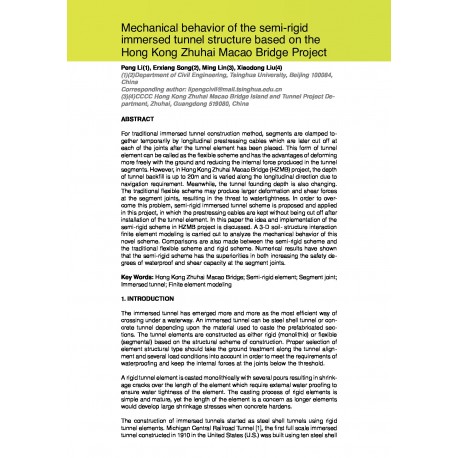Cart
0
0
No document
0,00 €
Total
Document successfully added to your shopping cart
Quantity
Total
There are 0 items in your cart.
There is 1 item in your cart.
Total documents
Total shipping
To be determined
Total
Search & filter
Search for a publication
Search & filter

Mechanical behavior of the semi-rigid immersed tunnel structure based on the Hong Kong Zhuhai Macao Bridge Project
260_mechanical_behavior_of_the_s
M. Lin / P. Li / X. Liu / E. Song
For traditional immersed tunnel construction method, segments are clamped together temporarily by longitudinal prestressing cables which are later cut off at each of the joints after the tunnel element has been placed. This form of tunnel element can be called as the flexible scheme and has the advantages of deforming more freely with the ground and reducing the internal force produced in the tunnel segments. However, in Hong Kong Zhuhai Macao Bridge (HZMB) project, the depth of tunnel backfill is up to 20m and is varied along the longitudinal direction due to navigation requirement. Meanwhile, the tunnel founding depth is also changing. The traditional flexible scheme may produce larger deformation and shear forces at the segment joints, resulting in the threat to watertightness. In order to overcome this problem, semi-rigid immersed tunnel scheme is proposed and applied in this project, in which the prestressing cables are kept without being cut off after installation of the tunnel element. In this paper the idea and implementation of the semi-rigid scheme in HZMB project is discussed. A 3-D soil- structure interaction finite element modeling is carried out to analyze the mechanical behavior of this novel scheme. Comparisons are also made between the semi-rigid scheme and the traditional flexible scheme and rigid scheme. Numerical results have shown that the semi-rigid scheme has the superiorities in both increasing the safety degrees of waterproof and shear capacity at the segment joints.



